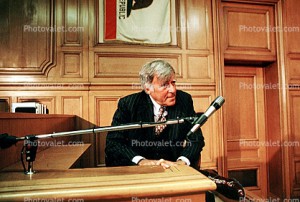Eyewitness Testimony and Memory is Not as Reliable as We Often Think It Is
It’s no surprise that in a trial of any sort, the witnesses usually make or break the case. And this goes without saying for eyewitnesses; those people who were supposedly there at the time the events in question took place. What they testify about is basically gold, in the eyes of the jury.
But there’s really not that much known, in the general public, about how reliable eyewitness testimony really is. Sure, we can count on a lawyer to cross-examine the eyewitness and point out the discrepancies in the testimony. But the thing is, unless an eyewitness makes it painfully obvious that he/she is biased, or is somehow unable to give accurate testimony, people basically assume that an eyewitness know what he/she is talking about.
Enter the growing field of psychology and the human memory. Experts, such as the noted psychologist Dr. Elizabeth Loftus, have been conducting experiments researching the relationship between eyewitness memory and the actual accuracy of it.
Basically, the research shows that eyewitness testimony is not really as reliable as we think it is. The studies show, in fact, that eyewitnesses actually have a large capacity for (unintentionally) making up false memories. Here are some of the reasons behind it:
1. The studies show that the more people imagine an event happening in the past (that did not actually happen), the more people will be convinced that the event actually took place. This phenomenon explains how people can end up creating false childhood memories, or make up details about events that never actually happened. Apparently, when we keep imagining certain scenarios, we can really come to believe these things happened.
2. Also, corroboration of the events by another person can have a huge affect on an eyewitness’s perception of something happening or not happening. This theory doesn’t seem too surprising. After all, how often have we had our thoughts swayed just because of something someone else had said?
3. Along similar lines, often times in their line of questioning, prosecutors and police can let their perceived notions of the events subtly come out. They may phrase questions a certain way designed to elicit a certain response, throw in additional details when asking questions, or keep repeating certain questions over and over again. Eyewitnesses can pick up on these hints and be influenced by what these authorities are subconsciously telling them.
For example, a prosecutor replying “that’s who we thought it was” after an eyewitness identifies someone, could have a huge impact on the eyewitness’s confidence level. This confidence level will, in turn, be very persuasive to juries.
4. Finally, studies show that people’s memories are not very accurate when it comes to recalling the happenings of a traumatic event. This conclusion should come as no surprise. After all, our brains function differently when we experience something traumatic.
Specifically, the studies show that when it comes to recalling traumatic events, we usually remember random details, and piece the facts together. Whereas, when recalling more ordinary events, we usually run the event over in our minds in a “video-recorder” fashion. Thus, the brain may have more difficulty recalling the happenings of a traumatic event.
 So now that we’ve established that eyewitness memory might not be as accurate as we think it is, what are some of the ways this could play out in an actual case?
So now that we’ve established that eyewitness memory might not be as accurate as we think it is, what are some of the ways this could play out in an actual case?
One situation to be aware of is the conformity effect. This refers to the situation when witnesses can come together to discuss the case, thereby influencing each other as to what each believed really happened. This could happen, for example, if witnesses were to run into each other at the police station after initial questioning. If the witnesses were already friendly with each other, they might discuss the case and end up tarnishing what they truly remember about it.
Another situation that comes up is the double identification effect. Basically, this happens when an eyewitness had actually seen the suspect prior to, or maybe after the event, and then mistakenly thinks the suspect was at the event as well.
For example, in a bank robbery case, an eyewitness in the bank may have seen the suspect as a passerby on the sidewalk before the robbery happened. Fueled by this memory, the eyewitness may then mistakenly believe that he/she saw the suspect in the bank robbery as well.
The danger with all these scenarios, as I briefly mentioned earlier, is that juries are very swayed by eyewitness testimony. More specifically, juries are particularly swayed when the eyewitness appears confident and can provide a lot of details. Unfortunately, as these studies show, it does not take a whole lot for an eyewitness to appear confident and provide lots of details.
However, by educating juries, judges, lawyers and the rest of the legal community about these theories, we might enable juries to better evaluate the accuracy of eyewitness testimony. I’m not saying that juries and judges should be required to take these theories into account, since they are just theories, but I don’t think it would hurt for them to be educated about these theories either.


Comments